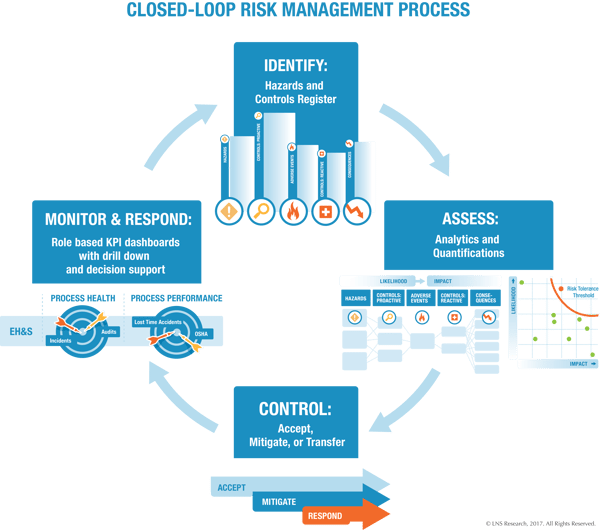More so than ever, the environment, health, and safety (EHS) business function is expected to contribute to sustainable, profitable growth of the enterprise. This is part of the natural evolution of the goals for EHS management over recent decades. Leading companies have shifted their focus away from mere compliance to proactive risk mitigation, Operational Excellence, and shareholder value.
Click here to speak to Peter Bussey.
 The widespread adoption of emerging digital technologies by industrial organizations presents EHS business leaders with an unprecedented opportunity to leverage advanced analytics capabilities to improve EHS and enterprise business performance. Modern technologies provide the information and insights needed to enable a more proactive, predictive approach to operational risk management in support of Operational Excellence objectives.
The widespread adoption of emerging digital technologies by industrial organizations presents EHS business leaders with an unprecedented opportunity to leverage advanced analytics capabilities to improve EHS and enterprise business performance. Modern technologies provide the information and insights needed to enable a more proactive, predictive approach to operational risk management in support of Operational Excellence objectives.
EHS Business Leaders are at a Digital Crossroads
Digital Transformation of industry is happening all around us. This trend goes by many other names such as Smart Manufacturing, Industry 4.0, and industry-specific flavors such as Digital Oilfield. Whatever it’s called, the industrial sector is widely embracing it. Our research shows that at least 64% of companies have undertaken Digital Transformation projects, or plan to do so within a year. Over 20% of these initiatives have been directed at solving safety and environmental problems.
The widespread adoption of digital technologies creates new business and operational risks to be managed, and new opportunities to optimize performance. Organizations now have an exponentially greater variety and volume of data available from many different sources. This includes data from sensors (from equipment, people, the environment), from mobile devices, captured in EHS and other business applications, and infinite other sources. This plethora of data is available for analysis and decision support, as are more sophisticated analytics tools to make sense of it. EHS leaders are at a digital crossroad. Those who recognize the potential will be well-positioned to take EHS performance to the next level and to contribute directly to overall business performance. Others risk falling behind.
Industrial Internet of Things (IIoT) and Predictive Analytics
The availability of low-cost sensors, cheap computing power, and wide-spread network connectivity are overarching technology trends enabling the Digital Transformation phenomenon. Within this environment, several critical technologies have emerged that power the Industrial Internet of Things (IIoT), and facilitate the digitalization of EHS management:
- Cloud computing
- Mobile applications
- Smart connected devices
- Big Data analytics
IIoT is the technology trend that enables new business models, processes, and insights based on cyber-physical systems and artificial intelligence. In industrial operations, this translates to a network of smart connected devices and assets with advanced data capture and analysis capabilities. The IIoT opens a world of possibilities to leverage new sources of data in new ways, to provide profound insights into performance improvement. Examples include machine and process performance data, connected worker data from wearable personal protection equipment (PPE), and work environment data -- all of which companies can incorporate into advanced Big Data analytics modeling.
With a wider variety and a larger volume of data for analysis, more information and insights are available to support smarter decision making. The net result is more visibility and control over EHS performance at a more granular level and the capability for predictive risk management. Advanced analytics can also support a closed-loop continuous improvement process by prescribing corrective and preventive actions, even with autonomous implementation.
Use Case: Mitigating Ergonomic Risk with IIoT-enabled Wearables
Ergonomic hazards leading to musculoskeletal disorders are among the most common and costly category of occupational injury. Digital technologies enable industrial, retail, and logistics companies to monitor biomechanical parameters of multiple employees during work activities with sensor-equipped vests. They upload data to the Cloud and apply machine learning algorithms to identify patterns, trends, and correlations to predict risk and develop corrective and preventive actions such as training and engineering controls. Organizations reduce injuries and costs and increase productivity by leveraging IIoT data and advanced analytics for predictive risk control.
Moving Forward with Advanced Analytics
The EHS business function has been mostly a bystander in the Digital Transformation movement. Most digital investments to date have been focused on operational improvements. Fortunately, EHS has been a significant, if unintended, beneficiary. For example, improvements in asset reliability help reduce equipment-related injuries, process safety incidents, and environmental emissions.
It’s time for EHS leaders to take advantage of digital innovation. This is best accomplished by engaging with your company’s Digital Transformation initiatives. Most industrial organizations already have Digital Transformation and IIoT projects underway, and many have a dedicated digital leader. EHS leaders should proactively align with and leverage existing digital initiatives and look for opportunities to participate. The EHS function will feel the impact of digitalization sooner or later, and it's better to act than be acted upon.
